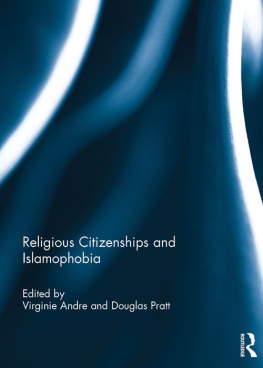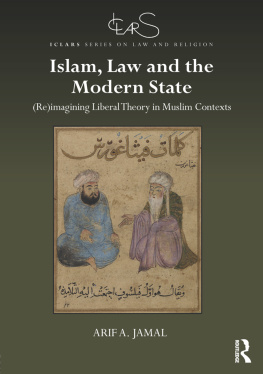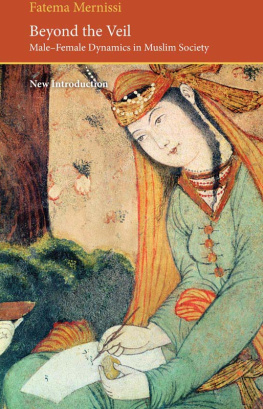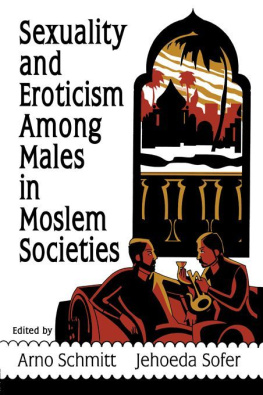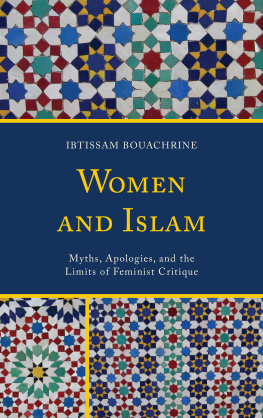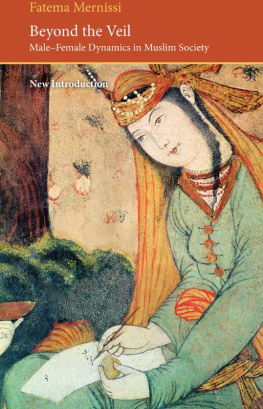
About the editors
A NISSA H LIE is assistant professor in history at John Jay College of Criminal Justice, New York. She is involved with various womens organizations and transnational networks, serving as director of the Women Living Under Muslim Laws International Coordination Office from 2000 to 2005. She has held research and teaching positions at Amherst and surrounding colleges, and is a board member of the Urgent Action Fund for Womens Human Rights and Reproductive Health Matters journal. She is co-author (with Jan Bauer) of Documenting Womens Rights Violations by Non-State Actors: Experiences of Activists from Muslim Communities (2006).
H OMA H OODFAR is a professor of anthropology at Concordia University, Montreal. She has extensively studied survival and empowerment strategies among those marginalized by legal constraints. She has also researched women in local and national politics, with a particular focus on Egypt, Iran, Afghanistan, Pakistan, and among Canadas Muslim communities. Her publications include: Health as a context for social and gender activism: Female volunteer health workers in Iran (2010); Women, religion and the Afghan education movement in Iran (2008); Between Marriage and the Market: Intimate Politics and Survival in Cairo (2005); and The Muslim Veil in North America: Issues and Debates (2003).
Sexuality in Muslim Contexts
RESTRICTIONS AND RESISTANCE
Edited by Anissa Hlie and Homa Hoodfar

Zed Books
LONDON | NEW YORK
Sexuality in Muslim Contexts: Restrictions and Resistance was first published in 2012 by Zed Books Ltd, 7 Cynthia Street, London N1 9J F , UK and Room 400, 175 Fifth Avenue, New York, NY 10010, USA
This ebook edition was first published in 2012.
www.zedbooks.co.uk
Editorial Copyright Anissa Hlie and Homa Hoodfar 2012 Copyright in this collection Zed Books 2012
The rights of Anissa Hlie and Homa Hoodfar to be identified as the editors of this work have been asserted by them in accordance with the Copyright, Designs and Patents Act, 1988
Designed and typeset in Monotype Bembo Book by illuminati, Grosmont
Index: rohan.indexing@gmail.com
Cover design: www.roguefour.co.uk
All rights reserved. No part of this publication may be reproduced, stored in a retrieval system or transmitted in any form or by any means, electronic, mechanical, photocopying or otherwise, without the prior permission of Zed Books Ltd.
A catalogue record for this book is available from the British Library Library of Congress Cataloging in Publication Data available
ISBN 978 1 78032 288 9
Acknowledgements
During a workshop in December 2008 organized as part of the Womens Empowerment in Muslim Contexts (WEMC) research project in Tehran, a heated discussion among scholars and activists arose around defining the field of sexuality. In their view, when sexuality was understood in a broad way participants could engage the public much more: their ability to discuss and mobilize around sexuality issues was enhanced whenever sexuality encompassed larger issues such as the reform of marriage law, reproductive rights, womens control over their bodies, the right of women and individuals to enjoy their sexuality, the importance of consensual sexual relations (including same-sex), as well as issues of dress code and compulsory veiling. They believed that the narrowing of the field, particularly after the Cairo conference (1994), and the increased focus on sexual orientation had actually disadvantaged LGBTTI groups, at least in the increasingly conservative Muslim contexts. They were sure that feminists faced similar problems in the rest of the Middle East and North Africa region, if not in many other Muslim contexts.
These concerns remained with me, even though I was aware that the reasons for the shrinking space for wider discourses on sexual rights and sexual minorities stemmed in large part from the rise of neoliberal economic policies, religious conservatism and fundamentalism, particularly under the leadership of the Vatican and proponents of Wahhabi Islam. When WEMC teams met in February 2009 in Hong Kong to discuss cross-cutting issues between the countries involved in the research, I presented the Iranian teams concerns. Instantly this opened up the debate. Indonesian team members had even more to say on the topic. In particular, they reflected on how political Islamists used the narrow equating of sexuality with LGBTTI to shut down any broader conversation on sexual autonomy, which in the end hindered holistic political advocacy for the rights of both women and stigmatized sexualities. Pakistani team members shared similar stories, particularly in areas where Taliban ideology had penetrated deep.
As a result of this workshop, with the support of Shirkat Gah Womens Resource Center (Lahore, Pakistan) and Concordia University (Montreal, Canada), we organized a subsequent workshop in April 2009 in Montreal and invited several experts in the field, including Anissa Hlie, to flesh out a broader conceptual framework on sexuality in Muslim contexts, exploring the intersections of various dimensions of sexuality, Muslimness and womens lives. This book is the result of that process. Anissa Hlie graciously accepted the invitation to join the book project and played a central role in making it happen. Anissa Hlie wishes to thank John Jay College of Criminal Justice, where she is an assistant professor in the history department, for the support it has extended to her: the teaching release was crucial and allowed her to focus on this project.
Anissa and I are indebted to many women who took part in the WEMC research project workshops, as well as contributors who joined us later to share their work with us. We are grateful to Shirkat Gah for its continued support for this project, and for providing us with the financial resources to make this book possible. We would like to thank Ariane Brunet, who agreed to participate in the April 2009 workshop, and who patiently hosted several subsequent working meetings, providing us with her valuable comments and insights along the way. Most especially we thank Farida Shaheed, whose timely interventions and continuous support were instrumental in transforming ideas into action. Without her this book would simply not have materialized. We are also appreciative of the efforts of our contributors, who patiently agreed to rework their chapters and address our comments; of Rima Athar, who was indispensable in coordinating this project, keeping in touch with our contributors, working on multiple drafts, and pulling together the final manuscript; and of Marlene Caplan, who worked under pressure of our deadlines as our external editor to improve our diverse styles of writing.
Glossary
Awrah Shameful; private parts for men, it is often defined as the area between knees and navel; for women, all the body apart from hands, feet and face. [In Indonesian and Farsi, aurat .] The term is linked to concepts of modesty (specifically what should not be seen in public), a notion that is subject to ongoing debates with the bodily parts that are considered awrah being redefined in various Muslim contexts.
Abaya A kind of overall worn as a style of veiling in some Muslim communities.
Ador Caresses. [Bengali]
Ahadith Plural of Hadith; sayings ascribed to the Prophet.
Ahkam Plural of hukm , rulings, law.
Ahong Female Muslim religious leader (i.e. women imams) in Mandarin from the origin of Farsi/Persian word akhond.
Amrad A term/concept referring to male teenagers who are often praised/objects of desire by older men for their youthful attractiveness and who may be involved in same-sex conduct.
Next page


